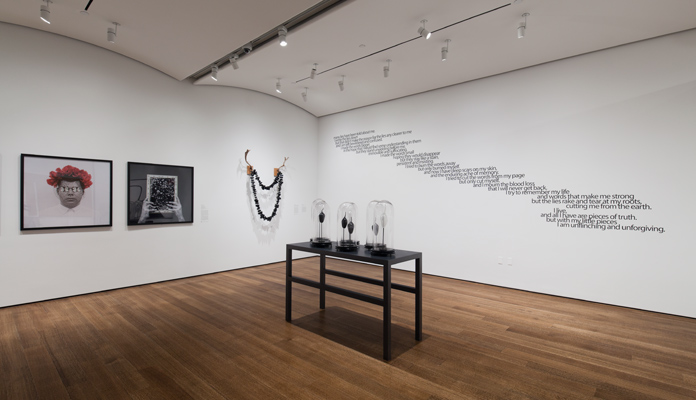“How do we gather the past into the present?” asked Stephen Gilchrist, the Australian Studies Visiting Curator at the Harvard Art Museums. All around him were what might be seen as answers: works of art by contemporary Indigenous artists from Australia—photographs, blown-glass sculptures, mixed-media installations, and more. They are part of the exhibition Everywhen: The Eternal Present in Indigenous Art from Australia,which explores the Indigenous concept of the elasticity of time.
Perhaps nowhere in Everywhen are the connections between past, present, and future more evident than in “Remembrance,” one of the exhibition’s four thematic sections. The works in this primarily black-and-white space evoke personal memories and collective histories. They address a commitment to ensuring that the past is not forgotten, and a desire to acknowledge the uneasy relationship between Australia, which came into existence only 228 years ago, and Indigenous peoples, who have inhabited the continent for about 40,000 years.
“Even today, Australia is confronting questions of who owns the land,” said Gilchrist, who belongs to the Yamatji people of the Inggarda language group of Western Australia, and is associate lecturer in art history at the University of Sydney and the curator of Everywhen. “These aren’t issues that are stuck in 1788; we’re still coming to terms with them.”
Many of the works in “Remembrance” refer to unsettling concepts and historical events that remain nearly unspeakable to Australians. Julie Gough’s Dark Valley, Van Diemen’s Land (2008), for instance, references the attempted extermination and forced exile of Indigenous people from Tasmania by colonists in the early 19th century (during the Black War). Gough’s work is a necklace of coal, created in dialogue with the traditional shell necklaces of the artist’s Indigenous ancestors. Formed in the shape of Tasmania, and hung from antlers, the work appears as a kind of trophy.
Yhonnie Scarce’s the silence of others (series of six) N2360, N2409, N2357, N2394, N1858, N2358 (2014) is a blown-glass work depicting traditional Indigenous foods, displayed as taxonomic specimens under glass domes. Each food item is inscribed with a number, which corresponds to numbers assigned to Scarce’s grandfather, great-grandfather, and great-grandmother, as they endured degrading scientific examinations by anthropologist Norman Tindale during the late 1930s.
“I wanted to reference how [my relatives] were seen as just objects for testing, and how they were disrespected as human beings,” said Scarce in an email interview. “You will often find documents relating to this research where there are only numbers stipulating who these people were rather than their names.”
Next to Scarce’s art, Vernon Ah Kee’s installation many lies (2004) fills a wall. The work, consisting of a diagonal slash of black text against a white background, addresses the perpetuation of falsehoods and the mistreatment of Indigenous peoples.
Ah Kee said he sees the work as an outlet to voice his frustration over being made to feel out of place in his own home. “Outside of the country we exist as people. Within Australia we exist as a kind of subhuman,” Ah Kee said, explaining that Indigenous Australians were never acknowledged by colonists with treaties or even a bill of rights (Australia has none). Indigenous Australians have a significantly lower life expectancy than their non-Indigenous counterparts, he said, attributing this to centuries of mistreatment and disrespect.
Despite—but also because of—these inequities, Ah Kee and Scarce see their art as a platform from which to share their stories. “I think we, as artists, are in a really strong position to speak out about the issues relating to the colonization of Australia and how this has affected us as Aboriginal people,” said Scarce, whose work was included in an official exhibition at the 55th Venice Biennale in 2013. “I am often referred to as a politically motivated artist, and I am happy to embrace that term. I find it empowering.”
Ah Kee, also a Venice Biennale veteran, said he sees activism—and the commitment to remembering history as well as educating others about the plight of Indigenous Australians—as an obligation. “We have to be responsible for describing ourselves,” he said. “We have to be responsible for demonstrating our complexity."


